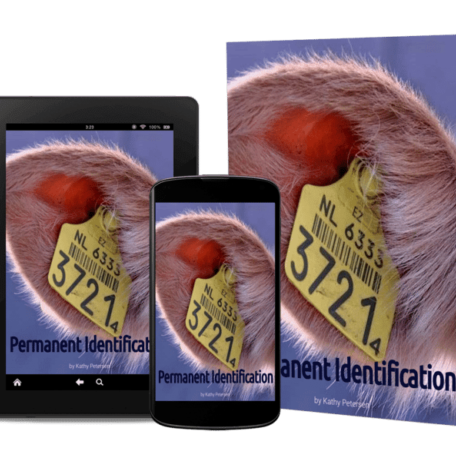
Sign Up
Want to receive a newsletter to learn more about KuneKune pigs and other educational information? Sign up to have them delivered right to your inbox.
We look forwarded to sending you some great info.
Permanent Identification eBook and Article
KuneKune Permanent Identification Methods
First, KuneKune Registries require permanent identification. Second, understand what permanent identification even means. Third, learn what type of identification is acceptable. Likewise, learn where you can purchase ear tags, microchips, and tattoo equipment.

IKKPS accepts microchips, tattoos, and ear tags
Permanent Identification for KuneKune Pigs Article
First, IKKPS requires all registered KuneKunes to have permanent identification. Second, this is done by the breeder before the pig/ piglet leaves your farm.
As a result of the required permanent identification, IKKPS accept microchips, ear tags or tattoos as a means of permanent identification in KuneKunes. Most importantly to note there is one KuneKune Registry that only accepts ear tags, which is the International KuneKune Hog Registry.
First, in this eBook we will explore what permanent identification in KuneKunes are, the benefits of permanent identification and what options there.
Identification of pigs going for sale or slaughter is an essential part of monitoring for diseases and chemical residues. To protect human health and maintain public confidence in pig meats it is vital that any disease, chemical contamination, or antibacterial residue is quickly traced back to its source. This allows the problem to be rectified before contaminated products get into the food chain. To meet the increasing demands of consumers for healthy and safe foods, identification at slaughter is essential in this process. The reputation of pig meats and therefore the viability of producers depends on reliable identification.
What is Premises Identification?
First, premises identification (premises ID) is part of the Animal Disease Traceability Framework (ADT) that is designed to help identify animals to the locations they have be raised on or passed through during their lives. Likewise, this number along with accurate movement records can serve as a critical piece of information in quickly tracing back an animal to a location in the event of an animal health emergency. o When registering a premises ID, the producer’s contact information (name, address, phone for primary and secondary contacts) will be recorded.
How do I obtain a premises ID number?
Obtaining a premises ID number is typically quite a straightforward process that involves contacting your state animal health agency. Find your respective state’s contact information by clicking here and accessing the list of state contacts. Likewise, you can google it. Contact your local USDA office for additional help, if you are having trouble trying to figure out who to contact.
Types of Permanent Identification
Microchip
A microchip implant is an identifying integrated circuit placed under the skin of an animal. The chip, about the size of a large grain of rice, uses passive RFID (Radio Frequency Identification) technology, and is also known as a PIT (Passive Integrated Transponder) tag.
Tattoo
Tattooing is a marking technique in which a permanent mark is placed in an unobtrusive area such as on the ear
of an animal. It consists of a pattern of closely spaced dark dots depicting numbers, letters, or a combination of
the two, imbedded in the bare skin using black ink, on the inside of the ear. Learn more below.
Ear Tagging
An ear tag is a plastic or metal object used for identification of domestic livestock and other animals. Electronic Identification Tags include the EID number and sometimes a management number on the button that appears on the back of the ear.
This is my preferred method of permanently identifying my herd. It is an easy, clean, and effective means of permanently identifying individuals within our herd.
See below for more information, including ordering information
Microchipping
Implanted by a veterinarian or at a shelter, these are my first choice as a former breeder. After checking that the animal does not already have a chip, the vet or technician injects the chip with a syringe and records the chip's unique ID. No anesthetic is required, it is a simple procedure and causes little discomfort: the pain is minimal and short-lived. A test scan ensures correct operation. A microchip implant is a passive RFID device. Lacking an internal power source, it remains inert until it is powered by the scanner or other power source.
**Implant the microchip yourself, it is extremely easy and will save you money. That is what we do here on our farm.
First, most implants contain three elements: a 'chip' or integrated circuit; a coil inductor, with a ferrite core; and a capacitor. The chip contains unique identification data and electronic circuits to encode that information. The coil acts as the secondary winding of a transformer, receiving power inductively coupled to it from the scanner. The coil and capacitor together form a resonant LC circuit tuned to the frequency of the scanner's oscillating magnetic field to produce power for the chip. The chip then transmits its data back through the coil to the scanner. via Microchip implant (animal) - Wikipedia
The easier way to say this is when you have a reader or scanner, it will show you the unique numbers of the microchip.
National Identification System
The United States uses the National Animal Identification System for farm and ranch animals other than dogs and cats. In most species except horses, an external ear tag is typically used in lieu of an implant microchip. Ear tags with microchips or simply stamped with a visible number can be used. Both use ISO 15-digit microchip numbers with the U.S. country code of 840 via Microchip implant (animal) - Wikipedia
To use USDA 840 chips, you must first have a premises id. That is obtained from your State. USDA accepts 840 microchips as a form of permanent identification.
Where to order:
Call the sales team on 1-877-330-3943 or 970-351-7701.
Elsie McCoy, Sales Manager
970-330-3943, 970-351-7701
Office Hours: Monday - Friday 7-5 Pacific Time
While this is not on a Kunekune you get the idea.
While this video is on microchipping a dog, it is the same on the KuneKune pigs but, you will microchip behind the shadow of the left ear in the soft fleshy part. Feel behind your ear. Feel that soft fleshy part? That is the same with the pig. Take a few moments and feel that on one of your KuneKunes.
Ear Tags
Due to a continued emphasis on livestock traceability within state and federal agencies and the livestock industry, the American Berkshire Association (ABA), Certified Pedigreed Swine (CPS) and Team Purebred (TP) now requires all animals being exhibited at ABA/CPS or TP events be identified with an official, permanently- numbered ear tag. The following information is designed to help answer questions about what is considered an official ear tag and how to obtain these tags.
What is a federally approved ear tag?
An official ear tag is a source of animal identification that, with accurate movement records, provides the ability to trace animals to their origin. o This capability is critical in the event of an animal disease emergency to help locate what points the animal has been in contact with. o Anyone who purchases federally approved ear tags will be required to submit their premises identification number when ordering. The premises ID number will then be recorded in a database and associated with the ear tag numbers from this purchase.
Where to order:
Also, if using 840 ear tags you can purchase from EZid (information under microchips)
I personally as KuneKune Breeder, never liked ear tags. There are some Kunekune Registries, like IKHR - International KuneKune Hog Registry that require ear tags. Recently they have changed the rules to only accept ear tags for registration.
Tattoos
Make sure that the number and letters are in the correct order on the striker plate - stamp a piece of cardboard or look at them in a mirror. Make sure that all needles on the brand are clean - grease, dirt, hair, and tattooing paste quickly build up on the needles. If not regularly cleaned the tattoo brand will become illegible. Clogged needles can also be a source of infection. Use only carbon-based tattooing paste or ink. Reapply paste or ink to the needles before each pig is tattoo branded. All needles must pierce the skin; take a good solid swing making sure that the face of the brand lands on the skin - it should leave a rectangular mark on the skin surface. Pigs with excessive dirt or soil may need to be washed on the shoulder area before tattooing. Brands with worn, broken or damaged needles should be replaced.
Where to order:
You can order tattoo equipment at Valley Vet.
Again, while this is not a KuneKune video it is the same. Most KuneKune Registries will recommend your breed prefix in the right ear or your KuneKune Registries initials in the right ear. Example: for IKKPS we would want IKKPS. For the International KuneKune Hog Registry they would want IKHR and for the American KuneKune Pig Society they will want AKKPS. (Please check with each registry for more information on their preferences and requirements). In the left ear you will put the registration number. Example: IKKPS 155 means the right ear would be IKKPS and the left ear would be 155.
We hope that you have found this helpful. IKKPS requires that all animals for registration be ear tagged, tattooed, or microchipped prior to leaving your farm. Please do not hesitate to let us know if you have questions.
Registry Office
17500 Hamilton Arms Court Dewitt, VA 23840